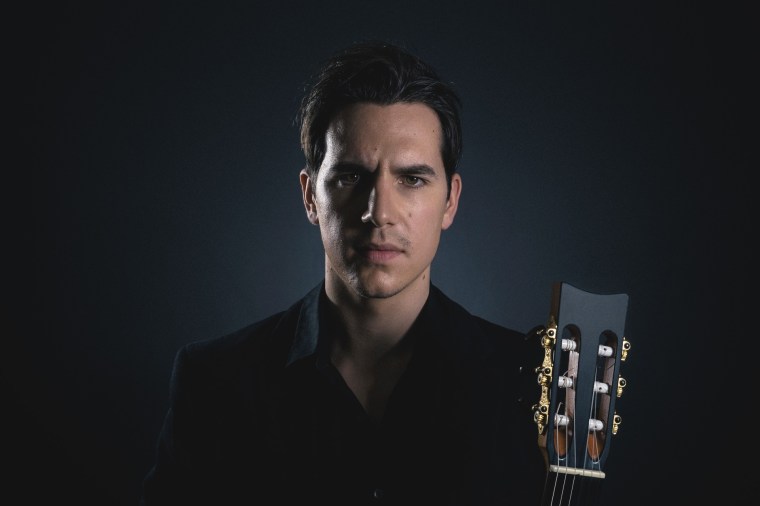Guest Post by luthier John Ray
All photos by Alberto Juárez
The Granada School of Guitar-makers, Part 2
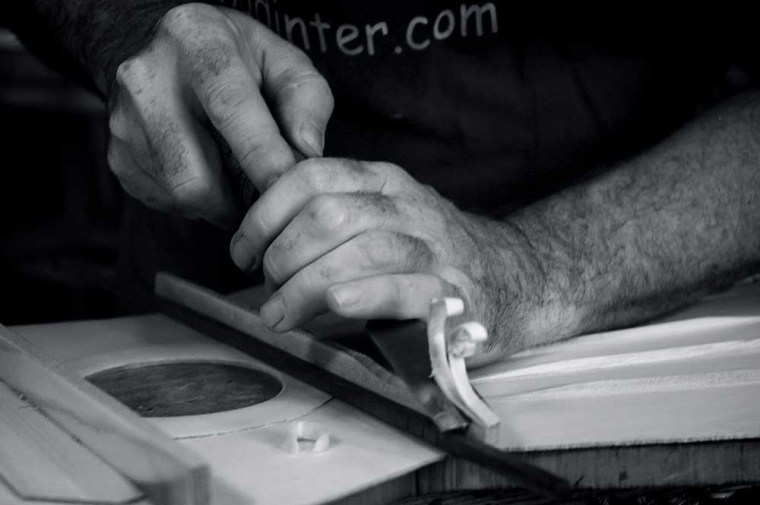 “If in Linares I was born into this world, it was in Granada that my eyes were opened to the beauty of life and art.” Andrés Segovia.
“If in Linares I was born into this world, it was in Granada that my eyes were opened to the beauty of life and art.” Andrés Segovia.
Architectural beauty and guitar music everywhere; centuries of history of the craft, age-old techniques and knowledge passed down in the workshops. People from all walks of life and some from different countries drawn to this most wonderful of instruments and applying their strengths to make this community better; surely these drive the Granada guitar-makers to rise above the rest and forge the stellar reputation that they have. How could we not produce Andrés Segovia, Manuel de la Chica and Antonio Marín? Where else would Antonio de Torres Jurado come to make his first guitar? What other city could Pepe Romero and Eliot Fisk possibly choose as their second residence? Where else can you find a guitar-making competition which brings young builders together to show their best work and to exchange ideas?
I arrived in Granada in 1989 hearing that it was a hotspot for guitar-making and thinking that surely I could learn here. Now in 2020 I am president of the guitar-makers association and my guitars can be found in shops in the U.S., Japan, China, South Korea, Germany, Australia and other countries. There is no doubt that Granada has been a centre for guitar-making for centuries and it still is. As for learning here, I had a long, challenging road and those who helped me get where I am hail from Granada but also from Germany, the U.S., Barcelona, Córdoba and Málaga.
Around the time I arrived the character of the Granada makers and their school of thought was crystalizing around two men and a series of events. Manuel López Bellido and Antonio Marín Montero had set up shop together in 1960 to make guitars, quite a few of which were sold under the labels of Eduardo Ferrer and Manuel de la Chica. As I wrote in Part 1, without the workshops of Ferrer and de la Chica the makers of the following generation would not have learned so quickly nor been so numerous. However, something happened under the leadership of Marín and Bellido which got players and dealers all over the world interested in the “Granada guitar”. These two men, like Eduardo Ferrer, travelled to Japan at the behest of some of their clients there and were an essential part of spreading the Granada tradition of building. Their growing skill and international projection combined with their generosity of spirit resulted in many of the guitar-makers in Granada working with them or learning from them at one time. Some of these trained with Eduardo Ferrer before or after their time with Montero y Bellido (which is what they first called themselves on the label). The death of Eduardo Ferrer signaled the end of an era and left the makers without the focal point that his workshop had become thanks to his strength of character and leadership and also left some of them without a job. For years he had brought the makers together and kept everyone on the same page. That role was filled by the formation of an association in 1987 just one year before his death and was started by 18 instrument makers. The name included the word Luthier because one of the members – José Mingorance – was a violin-maker; the preferred term is guitarrero. The other members were: Eduardo Ferrer Castillo (honorary president), Antonio Marín Montero (b. 1933), Manuel López Bellido (b. 1939), Francisco Santiago Marín (b. 1946), José López Bellido (b. 1943), José Marín Plazuelo (b. 1960), Francisco Manuel Díaz Fernández (b. 1942), Germán Pérez Barranco (b. 1940), Bernd Martin (1954-2018), Antonio Durán Zurita (1940-2006), Juan López Aguilarte (b. 1941), Rafael Moreno Rodríguez (b. 1954), Manuel Fernández Fernández (1930-?), René Baarslag (b. 1947), Antonio Raya Pardo (b. 1950), Juan Miguel Carmona Trapero (b. 1960) and Jonathan Hinves (b. 1956).
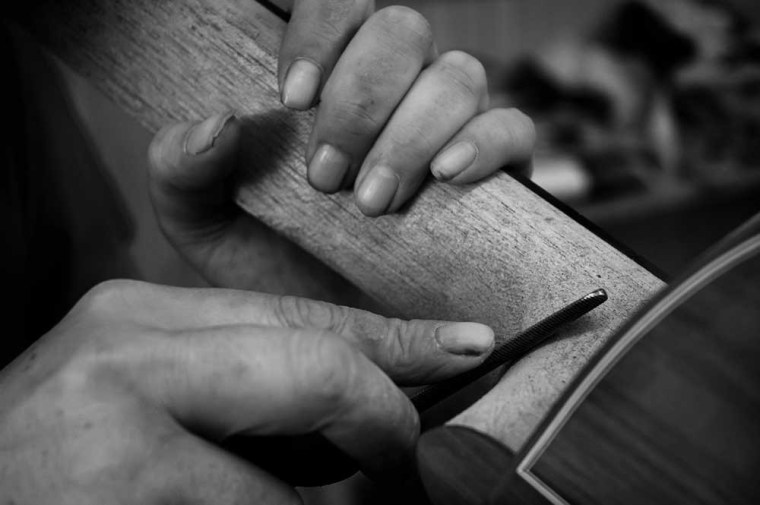 Another event closely related to the formation of this association is a an exhibition organized by the same group of makers. This was in 1989 and it helped to consolidate this important group. In addition to those mentioned above, the catalogue from this exhibition includes Juan Román Padilla (1928- 2018) who in an interview in 2012 assured me that he had ordered guitars for his label from the dúo Antonio Marín and Manuel Bellido. Also present was Antonio Ariza Rodríguez (1939-2006) who had spent some time with Eduardo Ferrer before striking out on his own.
Another event closely related to the formation of this association is a an exhibition organized by the same group of makers. This was in 1989 and it helped to consolidate this important group. In addition to those mentioned above, the catalogue from this exhibition includes Juan Román Padilla (1928- 2018) who in an interview in 2012 assured me that he had ordered guitars for his label from the dúo Antonio Marín and Manuel Bellido. Also present was Antonio Ariza Rodríguez (1939-2006) who had spent some time with Eduardo Ferrer before striking out on his own.
Although the term Granada School in reference to the guitar-makers here was used in different publications as early as 1968, it only became accepted or popular enough to be the default description when Eusebio Rioja used it in his book “Inventario de Guitarreros Granadinos” in 1976. This book with its second and third editions in 1983 along with the articles in British guitar magazines of 1977, 1988, etc. all contributed to delimiting who exactly represented the Granada School at the time. Rioja’s first edition was published before any of the foreigners arrived and in subsequent editions he chose not to mention them. However, in the various books and articles that used his information as a reference these great makers were included as they were in the association mentioned above.
The new guitar makers association, formed in 2017 organized a homage in 2019 to this influential group of makers on the occasion of an exhibition of early Granada guitars. The reason for this homage was the explosion of quality and quantity of makers in Granada buoyed by the dedication to their craft of these founding makers and their tireless work to promote it in the world, especially in Spain and the rest of Europe. They are the ones who were responsible for the quality and the reputation even today of Granada as a centre of world-class makers. The opening of the exhibition including a short concert on a 1851 Pernas guitar and a speech by the City Councillor for Culture brought these important artisans to the public’s attention.
Robert Bouchet’s collaboration with Antonio Marín in the 1970s is another turning point for the guitar in Granada. It is unclear whether his influence was more practical or artistic but there is no doubt that Antonio (and others in Granada) build a guitar today which is inspired in some of Bouchet’s ideas and that Bouchet ‘s contacts helped promote Antonio’s guitars which in turn promoted the Granada guitar. Bouchet’s generosity and aesthetic sense (both visual and aural) are evident in the guitars and the work of Antonio and his disciples.
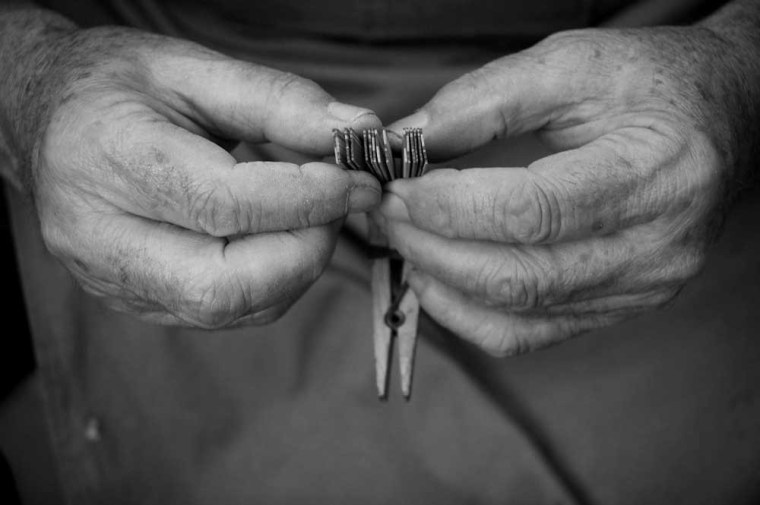 As mentioned, a few foreigners were already here making guitars but at the time of these events in the 1980s that is seems the floodgates opened and everyone realized that Granada was the place to be. Those drawn to Granada from other parts of Spain or elsewhere include Franz Butscher, Rolf Eichinger (1945-2009), John Ray, Stephen Hill, Mijail Kharash, Pavel Gavryushov, Henner Hagenlocher, Andrés Marvi, Mario Aracama, Olivier Marín, Johannes T’Kindt, Evan Kingma, Ayman Bitar and Knud Sindt. To different degrees all of these makers felt the influences of the original Granada School; some even learned directly from the founders.
As mentioned, a few foreigners were already here making guitars but at the time of these events in the 1980s that is seems the floodgates opened and everyone realized that Granada was the place to be. Those drawn to Granada from other parts of Spain or elsewhere include Franz Butscher, Rolf Eichinger (1945-2009), John Ray, Stephen Hill, Mijail Kharash, Pavel Gavryushov, Henner Hagenlocher, Andrés Marvi, Mario Aracama, Olivier Marín, Johannes T’Kindt, Evan Kingma, Ayman Bitar and Knud Sindt. To different degrees all of these makers felt the influences of the original Granada School; some even learned directly from the founders.
Before this explosive growth in the number of makers, the craft was passed on through family ties or apprenticeships in the larger shops. This continues today although perhaps to a lesser degree. Jesús Bellido, Mauricio Bellido, Miguel Ángel Bellido, Ana Espinosa Rodríguez, Daniel Gil de Avalle, José González López, Antonio Raya Ferrer, Eduardo Durán Ferrer, Lucas Martin, Juan Antonio Correa Marín, Francisco Díaz, Victor Díaz, Javier Rosales López and Luis Santiago Hernández all have family connections to the original Granada School through which they have learned or at least been inspired to take up the chisel.
And of course Granada natives and new residents find themselves drawn to the profession of guitar-making usually through contact with the Granada makers. Juan Manuel García Fernández, Aarón García Ruiz, José Luis Vigil Piñera, Juan Labella Manjón, Francisco Muñoz Alba, Sergio Valverde Castillo, Oscar Muñoz Sánchez, Francisco Hervás Hita and Francisco Heredia are examples of this. All of these people have enriched the guitar-making community with their skills and passions. In addition to the more typical origins like carpenters, musicians and cabinet-makers we have incorporated engineers, historians, economists, metal-workers, philosophers, firemen, teachers, linguists, salesmen and weavers to this burgeoning guild.
Some have come, worked here or studied with one of the makers and then moved on elsewhere: Thomas Holt, Matteo Vaghi, Valerio Licari, Daniele Chiesa, Philipp Neumann, Michael Ritchie, Anders Eliasson, Daniel Bernaert, Sergio Sánchez. In addition to these there are a great number of makers who have visited and been inspired by the work of the Granada school.
Another chapter on Granada might be the more active teaching outside of Granada that many of the makers have engaged in. David Gansz’ excellent contribution to the Granada guitar-makers book (see bibliography) lists makers who have spent time in Granada learning as well as Granada makers who have taught both in Granada and elsewhere.
“The influence of Granada builders has so permeated the world of guitar building – either directly via courses or seminars abroad or via visits to Granada by non-Spanish builders, or via builders studying Granada-made instruments – it is easy to conclude that Granada is in large part responsible for the fact that so many modern builders use traditional Spanish techniques.” – David Gansz

As reported by Javier Molina Argente, the town of Baza in Granada province was home to a number of guitar-makers since the 1980s: Vicente Checa Aro, José Checa Aro, Vicente Pérez Checa, Ramón García Durán, Antonio Ruiz, and Pedro Martínez Peñalver.
Of course one test of a group of makers or of one maker is particular is how well the guitars sell and who is playing those guitars. The fact that guitars from Granada are in shops all over the world and in the hands of the best players speaks volumes. However, the contribution to the community and the community’s recognition of the makers is also important. Over the years the efforts of the guitar-makers and the different public and private entities have brought to fruition the following incentives and publications.
The Granada School of Guitar-makers is a book published by the Granada Provincial Government in 2014 and an exhibition was celebrated on the occasion of its presentation. A short promotional video was also made. https://www.youtube.com/watch?v=Ns2uGqoJJlE&t=80s
Gloria Medina Luque organized an exhibition with the collaboration of Caja Rural Bank in 2016 which included included guitars made by historic as well as current Granada makers, concerts and conferences.
The Association meets with conservatory students every two years during the Guitar Encuentro (GNO) at the Conservatory and with the students of CSU’s Summer Arts.
In 2019 the Association of Granada Guitar-makers organized the exhibition of historic Granada makers and the homage mentioned to the original Granada School. You can visit this exhibition through this link. https://johnguitar.com/exhibition-tour/ The name of this exhibition was “Towards a Museum of the Guitar” and is part of a lobby to establish a museum in the city which best represents guitar history and construction in all of Spain (Granada of course).
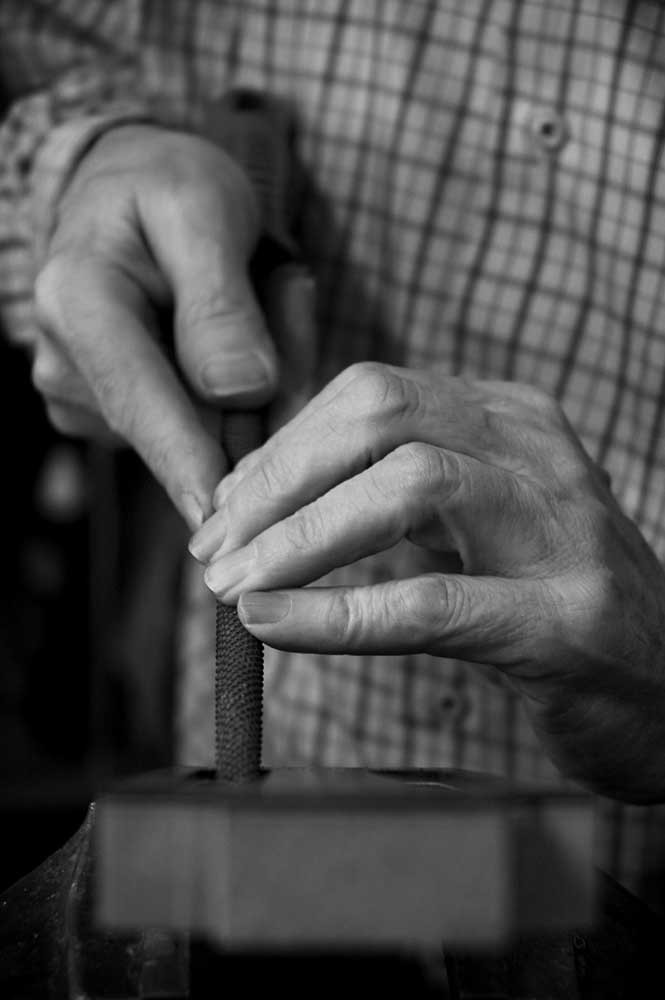
But when a young virtuoso asks me which guitar is right for him, as long as his eye is quick and his mind is open, there’s only one answer: go to Granada, stay a week and come back with the guitar that has made you see the difference between what you were and what you are. –Angelo Gilardino
The Englishman, Jonathan Hinves, told me, “Although there are many makers here, there is a very positive relationship with an enormous amount of mutual co-operation. Of course, there is always space for personal disagreement but we do get on with each other very, very well”. –George Clinton, Guitar magazine
…but neither of these guitar-building centres, nor any other in the world, can compete with the Granada artisan workshops in terms of quality, specialization, tradition and pure excellence. –Dr. Aarón García Ruiz
People often ask me what makes Granada so special. I tell them that Granada is the only place in the world where, instead of getting thrown out of my hotel for practicing my guitar and disturbing the other guests, the dueño of the hotel threw out the French girls who complained about my practicing. It’s a place where even the garbage man will ask me whether I play classical guitar or flamenco. Everyone in Granada is involved with the guitar in one way or another. It was no accident that from Granada a Segovia could emerge. –Lisa Hurlong
Now I think we can talk about what makes a guitar from Granada so desirable. Obviously all of this tradition and history gives the makers here resources to learn and perfect their skills. Competition between makers for clients means that each of us does the best we possibly can and make the best instrument possible. The opportunities for young makers to have their work critiqued by veteran builders are endless and this is perhaps the most important point. Advice may be given with kindly intent or scorn but it is almost always helpful. For the most part makers here value the traditional Torres style guitar and shun double tops and lattice bracing. We strive for and excel at achieving balance, beauty, dynamics and especially a broad tonal palette from which the guitarist can draw the sounds he or she requires in order to communicate through music. It is sound that we pursue, beauty and versatility. High end guitar dealers all over the world buy and sell guitars made in Granada
They really do have something special about them. My son expressed some interest recently in trying to create a new strain of plant by combining elements of other plants. His mother and I suggested he read up on Mendel and subsequent genetics work because in science you can always reach higher if you stand on the shoulders of those who have gone before. Perhaps this is the real secret to Granada’s continued success. So few builders can learn everything that has gone before whereas in Granada all that history, tradition, and techniques is just a stone’s throw away.

This article was written with the intention of shedding light on the recent history of guitar-making in Granada and to encourage guitarists to visit this wonderful province in their search for the guitar that fits them like a glove. I hope no one feels misrepresented or left out by the content of the preceding words.
John Ray has been living in Granada since 1989 and has been making guitars for over 20 years. In addition to being well-known for building copies of Antonio de Torres and Santos Hernández guitars he was the editor of the book “The Granada School of Guitar-makers”. https://johnguitar.com/contact/
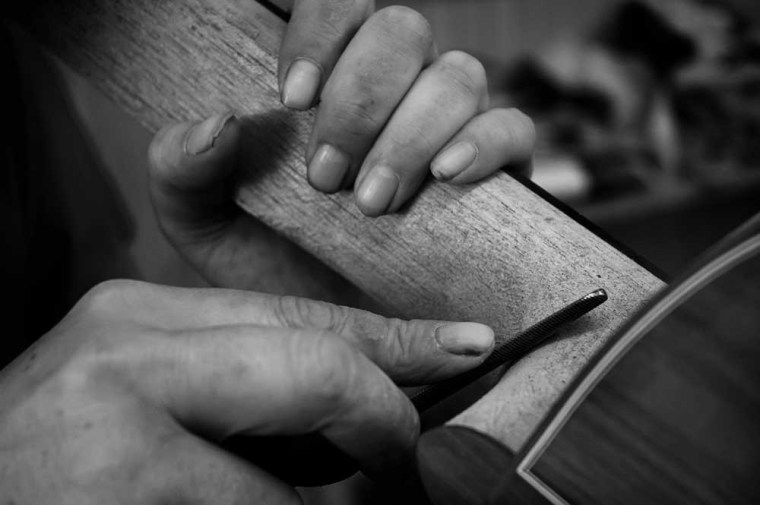
Sources:
Rioja, Eusebio. Inventario de Guitarreros Granadinos 1875-1983. Granada, Spain, Gráficas Monachil, 1983.
Hill, Kenny. “Visit to Legendary Granada.” http://www.hillguitar.com/website/news/articles/granada.html
Roberts, John. “The Guitar in Granada.” Guitar. February, 1977.
Clinton, George. “The Guitar Makers of Granada.” Guitar International. September, 1988.
Hurlong, Lisa. “¡Guitarra Granada Ole!” Soundboard. Summer 1990.
Clinton, George. “Bernd Martin.” Guitar International. August 1989.
Wade, Graham, “Robert Bouchet,” in The Classical Guitar: A Complete History, London, Balafon, 1997
Kasulen, Mark and Blackett, Matt. The History of Yamaha Guitars: Over Sixty Years of Innovation. Milwaukee, Hal Leonard, 2006.
“Escuela Granadina de Luthiers” (The Granada School of Luthiers), a series which ran in Guitar International magazine from September 1988 through July 1989.
Mairants, Ivor. “Granada: City of Guitars Makers, Part 2.” Classical Guitar. May/June 1984.
Huber, John. The Development of the Modern Guitar. Westport, Connecticut, Bold Strummer, 1994.
Ray, John. The Granada School of Guitar-making. Granada, Diputación Provincial de Granada, 2014 Includes articles by Angelo Gilardino, Alberto Cuellar, David Gansz, Aarón García Ruiz, Javier Molina Argente.
Promotional video for the book The Granada School of Guitar-making. https://www.youtube.com/watch?v=Ns2uGqoJJlE&t=95s
Martínez, Alberto. Orfeo Magazine No. 8 https://issuu.com/orfeomagazine/docs/orfeo_8_en
Valentí, Evaristo. “Granada guitar-makers: the first foreigners”

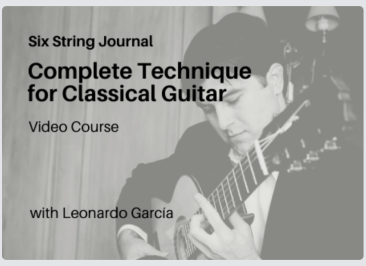
 “If in Linares I was born into this world, it was in Granada that my eyes were opened to the beauty of life and art.” Andrés Segovia.
“If in Linares I was born into this world, it was in Granada that my eyes were opened to the beauty of life and art.” Andrés Segovia. Another event closely related to the formation of this association is a an exhibition organized by the same group of makers. This was in 1989 and it helped to consolidate this important group. In addition to those mentioned above, the catalogue from this exhibition includes Juan Román Padilla (1928- 2018) who in an interview in 2012 assured me that he had ordered guitars for his label from the dúo Antonio Marín and Manuel Bellido. Also present was Antonio Ariza Rodríguez (1939-2006) who had spent some time with Eduardo Ferrer before striking out on his own.
Another event closely related to the formation of this association is a an exhibition organized by the same group of makers. This was in 1989 and it helped to consolidate this important group. In addition to those mentioned above, the catalogue from this exhibition includes Juan Román Padilla (1928- 2018) who in an interview in 2012 assured me that he had ordered guitars for his label from the dúo Antonio Marín and Manuel Bellido. Also present was Antonio Ariza Rodríguez (1939-2006) who had spent some time with Eduardo Ferrer before striking out on his own. As mentioned, a few foreigners were already here making guitars but at the time of these events in the 1980s that is seems the floodgates opened and everyone realized that Granada was the place to be. Those drawn to Granada from other parts of Spain or elsewhere include Franz Butscher, Rolf Eichinger (1945-2009), John Ray, Stephen Hill, Mijail Kharash, Pavel Gavryushov, Henner Hagenlocher, Andrés Marvi, Mario Aracama, Olivier Marín, Johannes T’Kindt, Evan Kingma, Ayman Bitar and Knud Sindt. To different degrees all of these makers felt the influences of the original Granada School; some even learned directly from the founders.
As mentioned, a few foreigners were already here making guitars but at the time of these events in the 1980s that is seems the floodgates opened and everyone realized that Granada was the place to be. Those drawn to Granada from other parts of Spain or elsewhere include Franz Butscher, Rolf Eichinger (1945-2009), John Ray, Stephen Hill, Mijail Kharash, Pavel Gavryushov, Henner Hagenlocher, Andrés Marvi, Mario Aracama, Olivier Marín, Johannes T’Kindt, Evan Kingma, Ayman Bitar and Knud Sindt. To different degrees all of these makers felt the influences of the original Granada School; some even learned directly from the founders.



